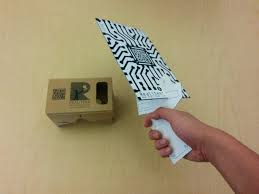I’ve been meaning to write a blog post about Virtual Reality (VR) for a while, and in particular what I call the ‘poor man’s VR’. My interest in it started when Google announced the Google Cardboard take on VR at Google I/O 2014. After seeing it I was really curious to see how good it actually was. (compared to things like the Oculus rift). Obviously it wouldn’t be comparable to custom PC driven VR but I just wondered what type of experience you’d get with a phone.
I looked at the designs which were free to download and make at the time, but after looking on the internet for the parts and finding them sold out everywhere it was clear that it had captured the imagination of many people like me.
It wasn’t until a few companies started appearing offering pre-built cardboard units that I managed to get my hands on one. The one I chose was ‘I Am Cardboard’. They seemed like they had loads of options and a few cool slants on the basic design.
The reason I created a blog post now though was another company called Realiteer has taken the idea of VR for the masses (on a budget) to the next level and create a slightly more interactive approach to cardboard apps which I thought was cool.
They have created a controller which can be used to translate movements in the real world to movements in the VR world. This is done by using the devices rear facing camera to read a bar code from a panel that you hold in your hand. They have also taken the same business model as cardboard too which is nice, so you can either buy a controller or download the design and make your own here. NOTE: It’s worth mentioning that you’ll need the Cardboard v1 version which has a hole for your camera in the design (otherwise you can cut your own hole if you have Cardboard v2!)
This design is a bit more straightforward than the cardboard self build though and after trying it out myself I think it’s quite good considering the limited hardware it operates from. At first it didn’t seem to register my movement of the controller in the VR game but after playing around a bit (and tilting the controller I found) it worked nicely. The company behind the controller have a couple of games, one free and one paid (79p) which let you use the controller.
Even thou this will never compete with the likes of oculus rift and does have its limitations (sometimes jerky and not always totally immersive) I really like the idea of enabling everyone to experience VR on a budget, making it more accessible, generating ideas to expand the platform for different uses and also have a bit of fun in the process. Here’s hoping this is just the start of many more cool ideas just like it! (A controller api would be awesome Realiteer! 😉 )




